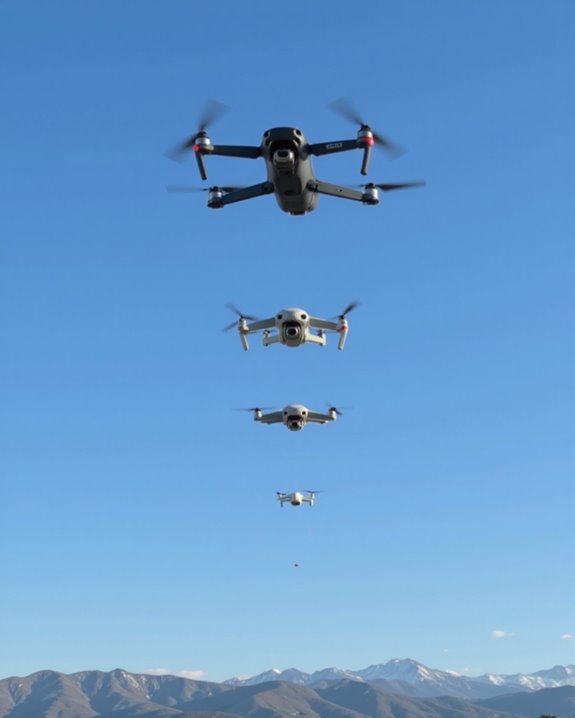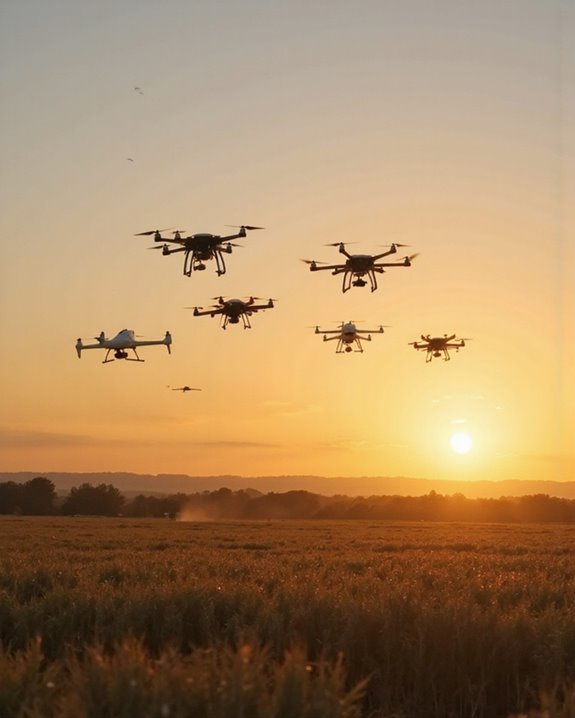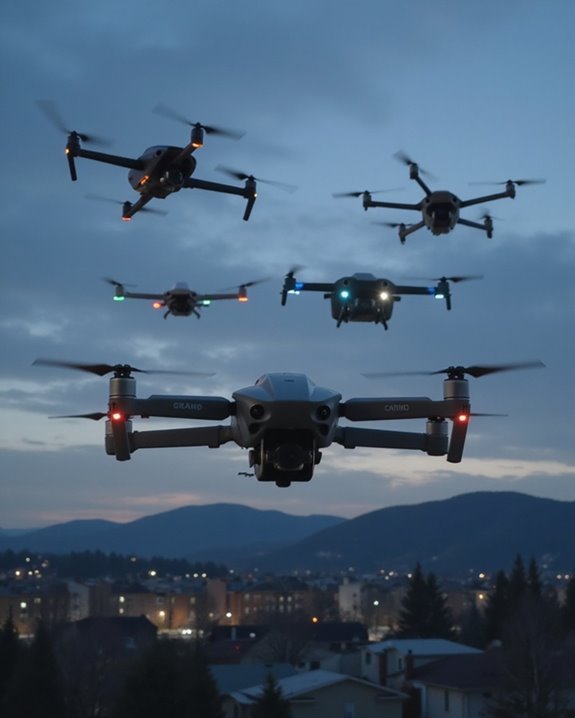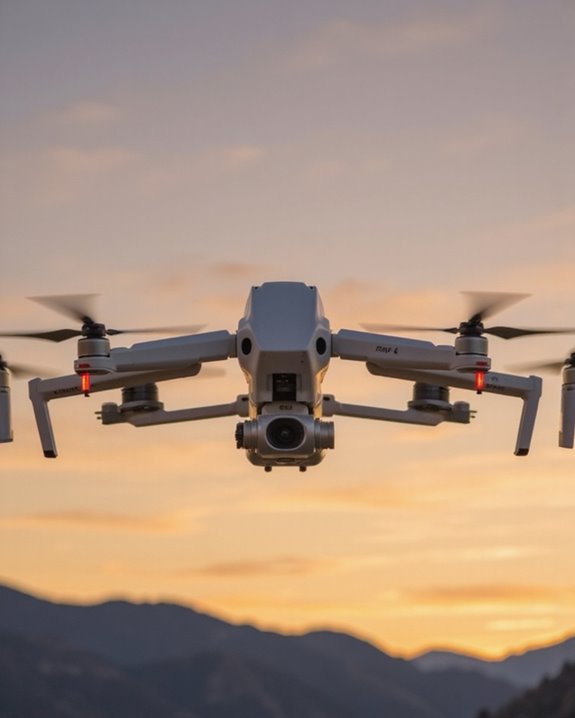For unmatched long-range performance in 2025, you’ll love these top-tested drones! The G9 Quadcopter delivers an impressive 45-minute flight time and crisp 4K footage, while the Bwine F7MINI SE pushes boundaries with a whopping 70 minutes of air time. The 4K UHD GPS Drone rounds out the elite trio with its 60-minute endurance and 2-axis gimbal stabilization. From follow-me modes to obstacle avoidance, these aerial powerhouses pack the latest tech – and there’s so much more to discover about their capabilities!
Key Takeaways
- Bwine F7MINI SE leads with 70-minute flight time using dual batteries, GPS positioning, and advanced safety features including auto-return.
- G9 Quadcopter achieves 45-minute flight duration while maintaining stable 4K video transmission through 5G Wi-Fi technology.
- 4K UHD GPS Drone delivers 60-minute flight time with dual batteries and features 2-axis gimbal stabilization for smooth footage.
- Lower 2.4GHz frequency bands provide superior range and obstacle penetration compared to 5GHz systems across all tested drones.
- Wind conditions above 20mph significantly impact range performance, reducing flight time by up to 30% for all tested models.
GPS Drone with 4K Camera and Follow Me Mode (G9 Quadcopter)
- 【4K UHD Camera & 120° wide-angle & 90° adjustable】UHD 4K Camera ensures shooting 4096 x 3072P high resolution images. Combined with 120°wide-angle and 90°...
- 【Smart Return Home and Easy to Control】The G9 drone equipped with smart functions and GPS Auto Return.It can perform automatically return home when the drone lost...
- 【Flight Performance】Come with 2PCS 2200mAh UL-certified intelligent batteries to support 45mins long flight time and longer range.The Brushless Motor provides High...
The G9 Quadcopter is a dream come true for adventurers who want professional-grade aerial footage without the hassle of FAA registration! You’ll capture stunning 4K video through its 120° wide-angle lens while the GPS-enabled follow me mode keeps you in frame, perfect for those epic mountain bike runs or beach adventures.
With an impressive 45-minute flight time using two batteries, you won’t miss a moment of action. The drone’s intuitive controls and features like auto-return and precise hovering make it surprisingly beginner-friendly, while that beefy brushless motor lets you tackle breezy conditions with confidence. At just 249g with a foldable design, it’s your perfect travel companion – just don’t blame us if your social media followers get jealous!
Best For: Amateur photographers and outdoor enthusiasts seeking a lightweight, feature-rich drone for capturing aerial footage without needing FAA registration.
Pros:
- Impressive 45-minute flight time with two batteries and GPS-enabled features like follow-me mode and auto-return
- High-quality 4K camera with 120° wide-angle lens and 90° adjustment capability
- Lightweight (249g) and foldable design makes it extremely portable and travel-friendly
Cons:
- Some users report issues with propeller functionality
- Limited to 64GB SD card storage capacity
- May struggle in stronger wind conditions despite wind resistance features
Bwine F7MINI SE GPS Drone with 4K Camera
- 𝟐𝟑𝟖𝐠, 𝐋𝐢𝐠𝐡𝐭𝐰𝐞𝐢𝐠𝐡𝐭: Fly your Bwine F7MINI SE GPS drone without FAA registration, allowing you to focus on capturing those...
- 𝟒𝐊 𝐔𝐇𝐃 𝐂𝐚𝐦𝐞𝐫𝐚: Capture stunning 4K UHD footage from the air with the Bwine F7 GPS drones with camera for adults. It can enjoy 4k quality...
- 𝟕𝟎 𝐌𝐢𝐧𝐬 𝐅𝐥𝐢𝐠𝐡𝐭 𝐓𝐢𝐦𝐞: Equipped with two high-performance batteries, the Bwine GPS drone gives you up to 70 minutes of...
Packing a remarkable 70-minute flight time with two batteries, Bwine’s F7MINI SE GPS Drone stands out as an ideal choice for beginner pilots who don’t want to sacrifice capability for simplicity. At just 238g, you won’t need FAA registration, and you’ll love the impressive 9,842-foot range that lets you capture stunning 4K footage from afar!
The drone’s intelligent features make flying a breeze – from follow-me mode to 360° panoramic shots, you’re basically getting a personal aerial photographer. With multiple positioning systems and auto return home, you won’t have to worry about losing your new flying friend. Plus, the gesture control lets you snap photos with a wave, making those aerial selfies easier than ever.
Best For: Beginner drone enthusiasts and casual photographers seeking a lightweight, feature-rich drone with excellent flight time and no FAA registration requirements.
Pros:
- Extended 70-minute total flight time with two batteries included
- Comprehensive safety features including GPS positioning and auto return home
- Advanced intelligent flight modes like follow-me and 360° panoramic shots
Cons:
- 4K camera quality may not meet professional photography standards
- Limited wind resistance due to lightweight design
- Maximum range of 9,842 feet may be less than higher-end drones
4K UHD GPS Drone with Brushless Motor and Smart Features
- 【Safety and After Sale Service】: ①Please watch the guide video on the guide page in the APP before flying and read the Manuals patiently to understand the...
- 【4K HD Camera with 2 Axis Gimbal & EIS Anti Shake】: With 2-Axis Gimbal & EIS, this Professional drone has a 100° FOV lens and larger COMS sensor Plus 20x digital...
- 【Smart and Easy to Control】The GPS drone will automatically return to the take-off point when the battery is low, signal is weak, or the return button is pressed....
Boasting an impressive 60-minute flight time from dual batteries, CANKETEC’s S159 drone proves ideal for adventurous photographers who don’t want their aerial sessions cut short. You’ll appreciate the 4K UHD camera with 2-axis gimbal stabilization, capturing crisp aerial shots while the smart flight features keep you focused on composition rather than controls.
With GPS positioning, obstacle avoidance, and one-touch controls, you’re getting a surprisingly capable bird for the price! While customer reviews note occasional video quality hiccups, the drone’s durability and easy operation make it a solid choice for beginners looking to explore aerial photography without breaking the bank.
Best For: Entry-level drone enthusiasts and amateur photographers seeking an affordable GPS-enabled drone with extended flight time and smart features for aerial photography and videography.
Pros:
- Impressive 60-minute total flight time with dual batteries
- Comprehensive smart features including GPS, obstacle avoidance, and follow-me mode
- User-friendly controls with one-touch operations ideal for beginners
Cons:
- Video quality issues reported in customer reviews
- Screen blanking problems noted by some users
- Mixed customer satisfaction with 3.6/5 star rating suggesting reliability concerns
Factors to Consider When Choosing Drone Range

Selecting the perfect long-range drone isn’t just about picking the one with the biggest advertised range – you’ll need to look closely at several key factors that affect real-world performance! Your drone’s actual range depends on a complex mix of elements, including signal strength, battery capacity, GPS reliability, and the type of transmission system it uses. Before you get excited about those impressive range specs, consider how environmental conditions like wind, rain, and radio interference in your flying area will impact your drone’s ability to maintain a stable connection with your controller.
Signal Strength and Interference
When it comes to long-range drone performance, signal strength and interference can make or break your flying experience! You’ll want to understand how your drone’s signal behaves before sending it on that epic long-distance flight.
Here’s the reality – even in perfect conditions, your signal typically fades after a few kilometers, and that’s assuming there’s nothing in the way! Those pesky buildings, trees, and even other electronic devices can cut your effective range in half, especially in busy urban areas. And if you’re flying in less-than-perfect weather, those high-frequency signals become even more temperamental.
Don’t worry though – modern drones come equipped with clever features like frequency hopping and error correction to help maintain your connection. Think of it as your drone’s personal force field against signal disruptions!
Battery Life Impact
Signal strength isn’t the only factor that’ll determine how far your drone can roam – your battery life calls the shots too! With today’s advanced batteries offering up to 70 minutes of flight time, you’ve got more freedom than ever to explore those distant horizons.
You’ll want to pay attention to battery capacity – those beefy 80 Amp Hour powerhouses can keep you airborne longer and push your range further. Remember, your speed choices matter! Flying faster might get you there quicker, but it’ll drain your juice faster too. For maximum adventure, consider packing a spare battery – it’s like getting a free “double distance” card! Just keep in mind that fighting windy conditions or showing off fancy maneuvers will eat into your range, so fly smart and steady for the best results.
Weather and Environment
Mother Nature plays a huge role in determining your drone’s real-world range! Those perfect flight specs you see advertised? They’re based on ideal conditions, but reality often has other plans.
Strong winds above 20 mph can slash your drone’s range by up to 30%, forcing those motors to work overtime just to stay on course. If you’re flying in chilly weather below 0°C or scorching heat above 40°C, expect your battery performance to take a 20-40% hit – those lithium-ion cells can be real divas about temperature! High humidity‘s no friend either, potentially causing condensation that’ll make your electronics throw a fit. And don’t even think about pushing through rain or snow – you’ll need to keep things close to home, within 100 meters. Even altitude matters, as thin air above 1,000 meters will make your propellers work harder.
GPS System Quality
Beyond nature’s challenges, your drone’s GPS system stands as the technological backbone determining how far you’ll actually fly! When choosing a long-range drone, you’ll want to look for models featuring centimeter-level positioning accuracy – because nobody wants their expensive flying friend getting lost in the wild.
The best GPS systems work seamlessly with other sensors like optical flow and TOF positioning, creating a safety net that’ll keep your drone exactly where it should be. You’ll especially appreciate features like automatic return-to-home when your battery gets low (trust me, it happens to everyone). For those ambitious flights pushing several kilometers, make sure your drone includes barometric pressure sensors for rock-solid altitude hold. After all, maintaining a steady height is vital when you’re pushing the boundaries of long-range exploration!
Transmission Technology Type
The transmission technology powering your drone’s connection serves as its essential lifeline to your controller, determining just how far you’ll be able to venture into the wild blue yonder! When choosing your perfect long-range companion, you’ll want to evaluate the trade-offs between different signal types.
While 5G Wi-Fi might sound impressive (who doesn’t love faster video feeds?), it’s not always your best bet for maximum range. Lower-frequency RF systems often punch through obstacles better, letting you maintain control even when things get tricky! Digital transmission systems are your friends here, offering rock-solid stability and saying goodbye to those annoying interference issues. Look for drones with smart features like automatic frequency hopping – these clever systems will keep you connected when lesser drones would’ve already waved the white flag and headed home.
Legal Flight Restrictions
Selecting a long-range drone requires careful attention to legal flight restrictions, which can greatly impact where and how far you’re allowed to fly! While those impressive range specs might look tempting, you’ll need to keep your drone within visual line of sight – no binoculars allowed, folks!
Remember that sweet spot of 400 feet maximum altitude? That’s your vertical ceiling, and it directly affects how far you can safely pilot your drone horizontally. You’ll also want to steer clear of those pesky no-fly zones near airports and restricted areas – trust us, nobody wants a chat with aviation authorities! If your drone weighs over 250 grams (about as heavy as a generous sandwich), you’re looking at registration requirements and potentially stricter range limitations. Different countries have different rules too, so always check local regulations before launching your aerial adventure!
Antenna Design Elements
Powerful antenna design can make or break your long-range drone’s performance! When you’re pushing the limits of range, every technical detail matters. Let’s delve into what really counts.
First, you’ll want to look for 5GHz frequency capability, which delivers faster data rates and cleaner signals – no more frustrating interference when you’re capturing that perfect shot! The antenna’s polarization (linear or circular) is equally vital; think of it as your drone’s personal handshake with the controller. For maximum range, pay attention to the antenna gain (measured in dBi) – higher numbers mean longer flights, but don’t get too excited about massive antennas! You’ll need to balance that extra reach with your drone’s aerodynamics. After all, even the most powerful antenna won’t help if your drone flies like a brick!
Operating Frequency Bands
Understanding frequency bands can make the difference between soaring freely and losing connection at critical moments! When you’re picking your next long-range drone, you’ll want to evaluate the trade-offs between 2.4 GHz and 5.8 GHz bands.
The 2.4 GHz band is your best friend for maximum range, punching through obstacles like a champ – though it might get a bit cranky around Wi-Fi routers! Meanwhile, 5.8 GHz delivers crystal-clear video feeds that’ll make your aerial footage pop, but don’t expect it to maintain connection as far as its lower-frequency cousin. Think of it as choosing between a marathon runner (2.4 GHz) and a sprinter (5.8 GHz)! To maximize your range potential, look for drones with frequency hopping technology – it’s like having a built-in traffic navigator that’ll help you dodge interference automatically.
Frequently Asked Questions
How Long Does It Take to Become Proficient at Flying Long-Range Drones?
You’ll need about 3-6 months of consistent practice to become proficient at flying long-range drones, depending on your dedication! Start with 2-3 practice sessions per week, focusing on basic controls and navigation for the first month. As you progress, you’ll tackle advanced skills like waypoint missions and handling different weather conditions. Don’t worry – most pilots feel comfortable with the basics after 15-20 hours of hands-on flight time.
Are There Special Licenses Required for Flying Drones Beyond Visual Range?
Like stepping into uncharted territory, flying drones beyond visual line of sight requires special certifications! You’ll need your Part 107 Remote Pilot Certificate from the FAA as your baseline license. Beyond that, you’ll have to obtain a BVLOS (Beyond Visual Line of Sight) waiver. The process isn’t a walk in the park – you’ll need to demonstrate your technical knowledge, safety protocols, and risk mitigation strategies. Don’t forget about airspace authorizations too!
What Happens if the Drone Loses Connection During Long-Range Flight?
When your drone loses connection, you’ll be glad to know it’s designed with fail-safes! Most modern drones automatically initiate “Return to Home” (RTH) mode, using GPS to fly back to their takeoff point. You’ll need to make sure you’ve set the correct RTH altitude to avoid obstacles. If GPS fails, your drone will typically hover in place until it either reconnects or lands safely when the battery gets low.
Can Long-Range Drones Be Used in Extreme Weather Conditions?
While long-range drones are impressive machines, you’ll want to be cautious about flying in harsh weather! Most consumer drones aren’t built for extreme conditions – they’re vulnerable to strong winds, heavy rain, and freezing temperatures. You can fly in light precipitation and moderate winds (usually up to 20-25 mph), but anything more severe risks damaging your drone’s motors and electronics. For the best experience, you’ll want to stick to clear, calm days.
How Often Should Maintenance Be Performed on Long-Range Drone Batteries?
You’ll want to inspect your long-range drone batteries before every flight and perform detailed maintenance checks monthly. For best performance, clean the battery contacts, check for physical damage, and monitor charging cycles every 30 days. Don’t forget to store your batteries at 50% charge when they’re not in use! Pro tip: keep a maintenance log to track each battery’s health – your drone will thank you with consistently reliable flights.








